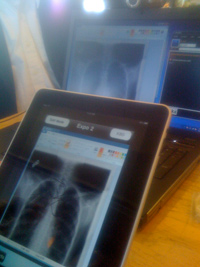![]() While many other vendors are building up their solution scope with extensive portfolio options, NEC has a simpler and more practical approach. The UNIVERGE solution incorporates unified infrastructure, unified communications and unified processes to create differentiated and powerful capabilities for their target customers in healthcare, hospitality, government and education markets.
While many other vendors are building up their solution scope with extensive portfolio options, NEC has a simpler and more practical approach. The UNIVERGE solution incorporates unified infrastructure, unified communications and unified processes to create differentiated and powerful capabilities for their target customers in healthcare, hospitality, government and education markets.
The three-layer approach portends a great deal of promise, as the company weathers these recessionary times, and brings to bear its significant product and engineering resources to enable higher productivity and lower costs in these cash-sensitive markets.
Infrastructure-wise, the company offers the SV8000-series of Communications Servers capable of IP or converged hybrid IP-digital telephony services, the WL-series of Wi-Fi network Access Points, Controllers and applications for engineering and managing advanced campus networks, and a portfolio of routers.
 In terms of unified communications, extensive softphone, presence indication, instant messaging, voicemail, videomail and both desktop and enterprise directory integration position the NEC solution set is quite extensive and attractive with its black metallic finish, a signature style first introduced in 2008. The UCE (Unified Communications for Enterprise) Desktop Client – UC700 – is shown at left and is the focal point for UC services for users. Significantly, the client can escalate communications as ad hoc conversations into multi-party conferences and ultimately into desktop video conferences. Integrating the client controls into the Microsoft Outlook toolbar, assures that real-time communications is never very far from the user.
In terms of unified communications, extensive softphone, presence indication, instant messaging, voicemail, videomail and both desktop and enterprise directory integration position the NEC solution set is quite extensive and attractive with its black metallic finish, a signature style first introduced in 2008. The UCE (Unified Communications for Enterprise) Desktop Client – UC700 – is shown at left and is the focal point for UC services for users. Significantly, the client can escalate communications as ad hoc conversations into multi-party conferences and ultimately into desktop video conferences. Integrating the client controls into the Microsoft Outlook toolbar, assures that real-time communications is never very far from the user.
A Practical Mobile UC
Mobile UC-wise, the company has earlier in 2009 introduced the UCE Mobility product, denoted the MC550. This is actually a web server adjacent to the SV8000-series platform that exposes the user administration of telephony service to a properly authenticated web browser. Users can configure their preferences for call handling from this mobile-device-optimized web portal which may or may not be activated using the browser of a mobile phone. This way, by using the browser of the laptop to simul-ring the mobile phone, any feature phone or smart phone can be activated and receive enterprise calls from the mobile phone.
The MC550 enables single number reachability, simultaneous ring, incoming-to-enterprise CLID, enterprise voicemail when calls are not answered, can present the corporate directory and initiate calls from the SV8000-series IP PBX to the mobile user. There are plans to deliver functionality enabling dual-mode smart phones support with WiFi-cellular handoff and softphone support on Wi-Fi phones. You can watch this space for an update on that capability in the coming months.
Probably most relevant is the effort that NEC is making to make mobile UC an easy transition for customers. Normally priced at $40 per end user license (buy more and the per unit price declines), the mobile UC and desktop UC software products are included in a special UCE-enhanced SV8500 Migration Package. As customers update their IP PBX software, they get a bundle of:
- OW5000 software for developers which includes APIs and tools for developing or integrating with NEC applications
- licenses for 200 UCE Desktop clients (UC700)
- licenses for 200 UCE Mobility clients (MC550)
- licenses for 20 UCE Softphones (SP30/SP350)
- 12 months of software assurance service
- Unlimited online end user training
The enhanced migration package presents extensive functionality for a large enough group so that the UC manager can deploy the capability to a reasonable community of users as a free pilot of sorts. If the manager can capture user feedback and anecdotes of the business impacts, they can make the case to broaden the pilot into a larger scale, multi-departmental deployment. According to NEC, the user training element is a critical component to successfully winning the hearts and minds of the pilot users and therefore are key enabler in getting the go-ahead to grow the deployment.









